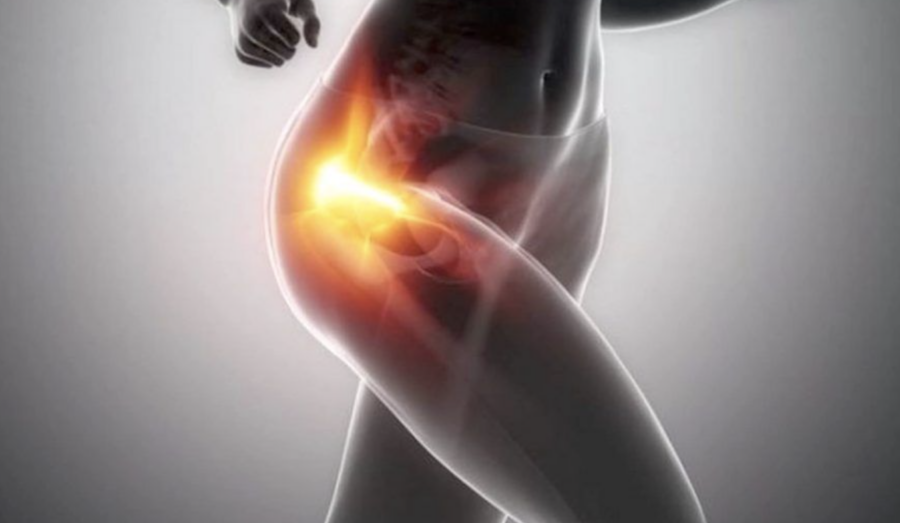Knowing the pyramidal syndrome

What is pyramidal syndrome?
The pyramidal syndromealso known as piriformis muscle syndrome, false sciatica o pseudosciaticais a neuromuscular condition caused by compression of the sciatic nerve. compression of the sciatic nerve in its passage through the gluteus. This compression is produced by crossing the canal between the piriformis and piriformis muscles. piriformis (also called piriformis) and superior gemellusdue to a contracture, fibrous band o overload of the muscle.
The pyramidal muscle is located deep in the gluteal region, extending from the sacrum to the femur. Near it runs the sciatic nerve, which originates in the lower back (lumbar area) and runs along the entire posterior part of the lower limb, reaching the toes.
When this muscle is under tension, it can compress the nerve and cause symptoms similar to those of lumbosciatica, although the origin is different: while true sciatica has its cause in the spine, the pyramidal syndrome occurs at the gluteal level.
Pyramidal syndrome and sciatica: how to distinguish them?
Both pathologies share symptoms such as pain radiating down the leg, but differ in their cause and location:
– Pyramidal syndromeThe compression of the sciatic nerve occurs outside the spine, specifically between the pyramidal and superior gemellus muscles, in the gluteal region.
– SciaticaCompression occurs at the vertebral level, usually due to a herniated disc. herniated disc or due to degenerative processes affecting the intervertebral discs.
The pain of pyramidal syndrome is usually increase in the sitting position and with movements such as crossing legs or going up and down stairs, while in sciatica (sitting) and with movements such as crossing the legs or going up and down stairs, while in sciatica, the symptoms usually depend more on posture and the condition of the spine.
It is estimated that pyramidal syndrome is responsible for more than 65% of cases of chronic non 65% of the cases of chronic non-disc lumbociaticai.e. pain radiating down the leg that does not originate in the vertebral discs.
Symptoms of pyramidal syndrome
Among the main symptoms presented by patients with this neuromuscular condition we highlight the following:
– Throbbing pain in the gluteal area.
– Numbness or tingling sensation in the buttock area and along the back of the lower limb.
– Pain that increases in the sitting position.
– Pain that worsens with activity (walking, running, standing for prolonged periods of time, etc.).
– Pain that increases with certain positions, such as sitting cross-legged or going up and down stairs.
– Reduced hip mobility due to excess tension and pain.
How is it diagnosed?
The diagnosis of pyramidal syndrome is clinicalthat is, it is based on the clinical history, signs and symptoms, and physical examination of the patient. Complementary tests such as magnetic resonance imaging may be used, but their function is usually to rule out other pathologiesThe role of MRI is to rule out other pathologies, as it does not usually provide conclusive findings on the pyramidal muscle.
How can we prevent pyramidal syndrome?
Pyramidal syndrome can be prevented with a combination of good postural habits and adequate physical exercise. Recommendations:
– Postural hygienePostural hygiene: essential for people who spend many hours sitting down.
– Strengthening of the abdominal, lumbar and abdominal, lumbar and gluteal muscles.
– Regular physical exercise.
– Pre-heating y stretching after physical activity.
In particular, it is recommended to establish a routine of about 15 minutes, two or three times a dayfocusing on stretching the gluteal musculature, the pyramidal muscle, the obturators, the hamstrings and the quadratus lumborum. Gentle and prolonged stretching is ideal both before and after exercise, preventing the muscle from contracting abruptly.
Treatment of pyramidal syndrome
The treatment of pyramidal syndrome is aimed at release the compression of the sciatic nerve and alleviate the symptomatology. It can be divided into three approaches:
Physiotherapeutic treatment
Physiotherapy is, in most cases, the treatment of choice, with good results in conservative management. The most commonly used techniques include:
– Massage therapy of the pyramidal muscle and the gluteal musculature.
– Dry needling on trigger points to deactivate contractures.
– Neurodynamics or mobilization of the sciatic nerve to free it from entrapment.
– Therapeutic stretching of the pyramidal muscle and associated musculature.
– Joint manipulations of the lumbopelvic of the lumbopelvic region.
– Personalized therapeutic exercise.
All these treatments should be performed by qualified professionals and, preferably, under medical indication.
2. Medical treatment
When physiotherapeutic treatment is not sufficient, it can be resorted to:
– Pharmacological treatment to relieve pain and inflammation.
– Infiltrations local injections to reduce nerve compression.
– In resistant cases, surgical treatment may be surgical treatmentespecially if the pain is severe and persistent.
At MIVI, we approach pain in a comprehensive manner
At MIVI Health we are experts in the treatment of pain and we approach pyramidal syndrome from a multidisciplinary and holistic approach. multidisciplinary and holistic approachadapted to the needs of each patient. We have a team of professionals specialized in physiotherapy, pain medicine and other disciplines.
If you have pain or doubts about our treatments, please contact us. We are here to help you.
References
- Ruiz-Arranz, J., Alfonso-Venzalá, I., & Villalón-Ogayar, J. (2008). Pyramidal muscle syndrome. Diagnosis and treatment. Presentation of 14 cases. Revista Española de Cirugía Ortopédica y Traumatología, 52(6), 359-365. https://doi.org/10.1016/s1888-4415(08)75586-3.
- Fernández De Las Peñas, C., & Dommerholt, J. (2013). Dry needling of trigger points: an evidence-based clinical strategy. Elsevier.
- Egea, M. A. (2019). Guia Clínica SoHAH | multidisciplinary manual for the management of chronic groin pain (Spanish Edition). Sociedad Hispanoamericana de Hernia.
- Piriformis Syndrome – https://www.ncbi.nlm.nih.gov/books/NBK448172/